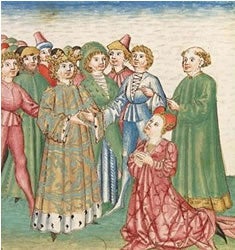Lire en Français
Medieval women writers as agents of cultural exchange: The case of Elisabeth Von Nassau-Saarbücken (Christine McWebb, University of Waterloo)
The study of female writers in the context of cultural exchange in the European Middle Ages and Early Modern period remains quasi-unexplored territory despite the now well-established concept of cultural exchange or cultural transfer in the humanities and the social sciences. It is for this reason that the German writer Elisabeth of Nassau-Saarbrücken’s works require critical attention and need to be made available to the English-speaking scholar and student.

Von Nassau-Saarbrücken is frequently referred to as one of the first German female authors writing secular texts in the vernacular. She is considered a literary novelty since she introduced the new genre of the prose novel into German literature during the first half of the fifteenth century.
The first chanson de geste Lion de Bourges is now available.